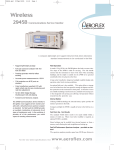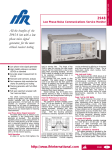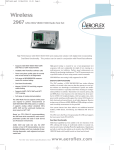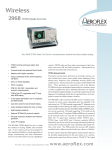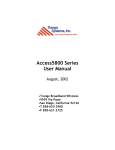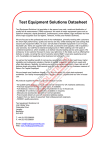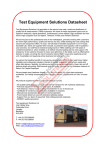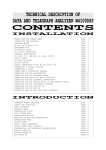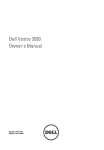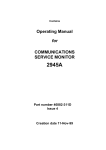Download Aeroflex-IFR-Marconi 2948 Datasheet
Transcript
Test Equipment Solutions Datasheet Test Equipment Solutions Ltd specialise in the second user sale, rental and distribution of quality test & measurement (T&M) equipment. We stock all major equipment types such as spectrum analyzers, signal generators, oscilloscopes, power meters, logic analysers etc from all the major suppliers such as Agilent, Tektronix, Anritsu and Rohde & Schwarz. We are focused at the professional end of the marketplace, primarily working with customers for whom high performance, quality and service are key, whilst realising the cost savings that second user equipment offers. As such, we fully test & refurbish equipment in our in-house, traceable Lab. Items are supplied with manuals, accessories and typically a full no-quibble 2 year warranty. Our staff have extensive backgrounds in T&M, totalling over 150 years of combined experience, which enables us to deliver industry-leading service and support. We endeavour to be customer focused in every way right down to the detail, such as offering free delivery on sales, covering the cost of warranty returns BOTH ways (plus supplying a loan unit, if available) and supplying a free business tool with every order. As well as the headline benefit of cost saving, second user offers shorter lead times, higher reliability and multivendor solutions. Rental, of course, is ideal for shorter term needs and offers fast delivery, flexibility, try-before-you-buy, zero capital expenditure, lower risk and off balance sheet accounting. Both second user and rental improve the key business measure of Return On Capital Employed. We are based near Heathrow Airport in the UK from where we supply test equipment worldwide. Our facility incorporates Sales, Support, Admin, Logistics and our own in-house Lab. All products supplied by Test Equipment Solutions include: - No-quibble parts & labour warranty (we provide transport for UK mainland addresses). - Free loan equipment during warranty repair, if available. - Full electrical, mechanical and safety refurbishment in our in-house Lab. - Certificate of Conformance (calibration available on request). - Manuals and accessories required for normal operation. - Free insured delivery to your UK mainland address (sales). - Support from our team of seasoned Test & Measurement engineers. - ISO9001 quality assurance. Test equipment Solutions Ltd Unit 8 Elder Way Waterside Drive Langley Berkshire SL3 6EP T: +44 (0)1753 596000 F: +44 (0)1753 596001 Email: info@TestEquipmentHQ.com Web: www.TestEquipmentHQ.com At under 12 kg the 2948 lightens the load to remote sites. The shape of the 2948 is ideal for carrying; the side handle ensures that the instrument is clear of the stairs when ascending buildings and the 2948s depth is suitable for the instrument to be operated comfortably when it is placed on the floor. An optional bail arm handle is also available. This option allows a stowage cover to be fitted over the front panel for storage of adapters and further protection to the instruments front panel. Full operation is possible from the protective ever-ready case so that your investment is protected from transit damage. Stored settings may be recalled from internal memory or from a memory card allowing fast and straightforward setting up. The 2948 differs from its 2945A cousin by providing a low phase-noise signal generator as standard. This enhanced capability allows accurate measurement of the noise characteristics of all FM receivers and is especially beneficial when making accurate measurement of narrow band receivers. The performance of the 2948 enables signal-tonoise measurements of better than 46 dB to be made on receivers with 12.5 kHz channel spacing. The spectrum analyzer provides spans from 100 Hz per division to 100 MHz per division and also has a fully adjustable reference level. Speed is comparable with analog analyzers, allowing real time adjustments over the displayed dynamic range. With the tracking generator provided as standard, duplexers and filters can be aligned quickly and easily. An offset facility provides testing of equipment with fre- quency translation. Channel stepping can be performed by defining an increment and then using the FREQ keys. This is particularly useful when testing multi-channel systems. This feature puts the 2948 above all of its peers with the ability to examine signals on the screen and demodulate them simultaneously. Intermittent interference can be isolated quickly and the signals then easily identified. The trace can be saved to memory card along with the time and date, providing factual evidence that can be recalled later. This feature is particularly useful when looking for rogue transmissions, especially on busy base station sites. Remote control is provided, with an RS-232 interface as standard. An IEEE-488.2 interface (option 5) can be fitted where other instruments are required to operate in a system with the 2948. With the parallel printer port interface, screen dumps, automatic test results or previously stored results may be sent to most parallel printers. These facilities are available as standard using the serial RS-232 interface. A screen capture facility is available so any screen displayed on the 2948 can be saved direct to a PC via the serial port as a bit map file. The 2948 measures the power of low level signals such as those encountered when monitoring off-air signals or those found when probing a circuit. 150 Watts measurement is provided without the need for external attenuators, so the high power of base stations can be measured directly. Measurement accuracy of better than 10% is guaranteed all the way down to 5 mW on the N-Type connector, allowing cellular radios to be qualified at low power levels. Users may program the instrument to suit their own specific needs. This is possible either by configuring any of the 4 built-in programs or by using the MI-BASIC interpreter to produce a customised test program that can be executed internally, without an external controller. The signal generator provides coverage from 400 kHz to 1.05 GHz with +5 dBm output (+7 dBm overrange) and fast switching speed. Level accuracy is ±2 dB at all levels above -127 dBm. With the Analog Systems Card fitted, automatic testing without an external controller is possible. Custom tests may be written and run by the operator. Four programmable relay contacts are provided with the optional parallel printer interface. This allows remote control of radios or test fixtures from built-in automatic tests. Full duplex operation is provided by the 2948. This allows testing of duplex radios as well as simultaneous testing of repeater transmit and receive paths. There are no restrictions to the duplex offset. AMPS, TACS and NMT analog cellular standards are available internally, with all country variants provided in each package. Trunking for MPT 1327/1343 and variants of them is also available. A new trunking capability has been added with the introduction of EDACS Radio and Repeater test capability. Remote control of the inbuilt tests is provided, so that measurements can be started and results logged automatically. The memory card drive meets the PCMCIA standard format for PC cards. The 2948 provides a DOS based filing system that allows transfer of information to a PC fitted with a memory card slot. Test setups, test results, screen dumps, spectrum analyzer co-ordinates and test sequences can all be stored on the memory card, allowing information to be easily stored and retrieved when required. The 2948 features high integration and a chassis designed to maximise mechanical protection. The 2948 simulates the signalling protocol that the radio would see from the real network. This allows calls to be set up and handled enabling receiver and transmitter parametric measurements to be made. A comprehensive range of filters are provided as standard, including band pass, low pass and high pass. Optional filters are available for psophometric weighting of audio signals and demodulation of signals in a simulated radio channel bandwidth. The direct measurement of CTCSS is possible with the 300 Hz LP filter, even with speech present. Two comprehensive audio generators are provided as standard for internal modulation or audio sources for transmitter stimulus. External DC coupled FM is provided. FREQUENCY Analysis of audio signals, whether from the demodulated signal or the audio input direct can be viewed for further inspection. The oscilloscope can either be combined with the measurement screen in the Tx, Rx or AF test modes or zoomed to a full screen display. Different levels of persistence can be selected to allow short or long term effects to be captured. Frequency Range 400 kHz to 1.05 GHz Resolution 10 Hz Indication 10 digit display Setting Keyboard entry, delta increment/decrement function and rotary control Accuracy As frequency standard The ability to capture transients on the rising or falling edge of a waveform provides a valuable tool for fault finding radios and radio systems. The user has full control of the trigger level and input attenuation as well as the timebase and five fixed trigger points, making this feature simple and flexible to operate. OUTPUT LEVEL Output Level Range Rx Test: An automatic harmonic analysis function is included in the 2948. This complements the fast spectrum analyzer and allows a rapid check that the transmitter under test is not producing any excessive harmonics. N-Type socket: -141 dBm to -21 dBm BNC socket: -115 dBm to +5 dBm (overrange to +7 dBm) Resolution 0.1 dB The tones menus include full remote control so that radio workshops can further automate their tasks and better control the tones from the top level screens. Indication 4 digits plus sign (dBm, dBµV, µV, mV PD/EMF). Accuracy ±2 dB for level above -127 dBm on N-Type socket up to 1 GHz Off-air decoding of POCSAG signals is provided as an option. Reverse Power Protection This allows tone, numeric and alphanumeric messages to be displayed. Signals with bit rates of up to 4800 bits/s can be automatically decoded making the 2948 an ideal surveillance tool. The 2948 can be set to detect all messages, a user selectable RIC (just like a pager), or a fixed message string. N-Type: 50 W 10 minutes, normal operation. 150 W for 1 minute at 20 °C. Overload indicated by audible and visual warning. BNC: 5 W Overload indicated by audible and visual warning. Output Impedance Nominally 50 VSWR N-Type Better than 1.2:1 up to 500 MHz Better than 1.35:1 up to 1.05 GHz BNC Better than 2.2:1 up to 1.05 GHz SPECTRAL PURITY FREQUENCY MODULATION - INTERNAL Residual FM Frequency Range Less than 6 Hz RMS (0.3 to 3.4 kHz) up to 500 MHz Less than 12 Hz RMS (0.3 to 3.4 kHz) up to 1.05 GHz 400 kHz to 1.05 GHz Maximum Deviation Harmonics 75 kHz -25 dBc Indication 3 digits Spurious Signals Better than -50 dBc SSB Phase Noise (20 kHz offset) Better than -112 dBc/Hz up to 500 MHz Better than -108 dBc/Hz up to 1 GHz RF Carrier Leakage Less than 0.5 µV PD generated in a 50 load by a 2 turn loop 25 mm from the case. Output level less than -40 dBm into a sealed 50 load. AMPLITUDE MODULATION - INTERNAL Setting Keyboard entry, delta increment/decrement function and rotary control Accuracy (1) ±7% at 1 kHz modulating frequency ±10% at modulating frequencies from 50 Hz to 15 kHz Distortion Less than 1% at 1 kHz for deviation of 5 kHz, CCITT weighted Modulation Frequency Range 20 Hz to 25 kHz Frequency Range 400 kHz to 1.05 GHz Resolution 25 Hz AM Depth Range Pre-emphasis 0 to 99% 750 µs selectable Resolution FREQUENCY MODULATION - EXTERNAL 1% Indication Input Impedance 2 digits Nominally 10 k Frequency Range Setting Keyboard entry, delta increment / decrement function and rotary control Accuracy As internal FM Modulation Frequency Range DC to 100 kHz For carrier frequencies from 1.5 MHz to 400 MHz ±5% at 50% for modulation frequency of 1 kHz. ±7% ± 1 digit for modulation frequency of 1 kHz. ±15% ±1 digit for modulation frequencies from 50 Hz to 15 kHz. Distortion Pre-emphasis 750 µs selectable Sensitivity 1 VRMS for 0 to 75 kHz deviation MICROPHONE INPUT Less than 2% at 1 kHz for 30% AM, CCITT weighted Modulation Frequency 20 Hz to 20 kHz Input Level 2 mV to 200 mV (AGC levelled) Input Impedance AMPLITUDE MODULATION - EXTERNAL Input Impedance Nominally 10 k in parallel with 40 pF Nominally 150 Press To Talk (PTT) in parallel with 40 pF Frequency Range When using the optional microphone in Tx Test mode, the PTT will switch instrument to Rx Test. As internal AM Modulation Frequency Range As internal AM Sensitivity 1 V RMS for 100% AM Input Impedance Nominally 1 M in parallel with 40 pF Frequency Range DC and 50 Hz to 50 kHz AC only 50 Hz to 50 kHz Polarized DC (below 1 Hz) Maximum input voltage Resolution 30 VRMS, 50 Vdc 0.1% distortion Level Ranges Indication 0 - 100 mV to 0 - 100 V RMS in a 1, 3, 10 sequence 3 digits and bar-charts Digital readout also in mW (user selectable) Accuracy ±1 dB of reading ± 0.5% distortion Resolution 1 mV or 1% of reading Sensitivity 50 mV (100 mV for 1% distortion) reading suppressed if audio voltage is less than 5 mV Indication 3 digits and bar-chart Accuracy AC ±3% ±3 mV ± resolution up to 30 V RMS Range Accuracy DC 0 to 30 dB and 0 to 100 dB ±1% +50 mV up to 40 V Resolution 0.1 dB Indication Frequency Range 3 digits and bar-chart 20 Hz to 50 kHz Accuracy Resolution ±1 dB 0.1 Hz, less than 10 kHz 1 Hz, at 10 kHz and above Sensitivity 50 mV (100 mV for 40 dB S/N) reading suppressed if audio voltage is less than 5 mV Indication 5 digits Accuracy As frequency standard ± 1 digit ± resolution Operating Modes Sensitivity Single or repetitive sweep 50 mV Frequency Range DC to 50 kHz, 3 Hz to 50 kHz AC coupled Voltage Range Frequency 10 mV to 20 V per division in a 1, 2, 5 sequence 1 kHz Voltage Accuracy Range ±5% of full scale 0 to 18 dB and 0 to 50 dB FM Ranges Resolution ±75, 30, 15, 6, 3 and 1.5 kHz deviation full scale, ±10% accuracy 0.1 dB AM Ranges Indication 20, 10 and 5% per division, ±10% accuracy 3 digits and bar-charts Timebase Accuracy 50 s/div to 5 s/div in a 1, 2, 5 sequence ± 1 dB Graticule Sensitivity 50 mV (100 mV for 40 dB SINAD) reading suppressed if audio voltage is less than 5 mV 10 Horizontal by 6 Vertical divisions Special features Built in antialiasing circuitry and variable decode trigger level Frequency 1 kHz Bar-chart Displays AF Voltage, SINAD, Distortion, S/N Range 0 to 10% and 0 to 30% Vertical Resolution 2% of full scale Ranging Autoranging, range hold or manual selection 1, 2, 5, sequence with hysteresis Audio and Modulation Filters 300 Hz, 3 kHz, 15 kHz Lowpass 300 Hz to 3.4 kHz Bandpass 300 Hz Highpass 750 µs de-emphasis 50 kHz Lowpass (No filters applied) Resolution 0.1 dB max, typically 1% Accuracy (N-Type) ±10% ± resolution up to 1 GHz Maximum Continuous Rating N-Type: 50 W at 20 °C BNC output: 5 W Antenna port: 1 W Intermittent Rating N-Type: 150 W for limited periods, typically 1 minute at 20 °C. Overload indicated by audible and visual warning. Audio Analyzer General Features Tones Mode Frequency Range 400 kHz to 1.05 GHz (manual tune) 10 MHz to 1 GHz (autotune) Resolution 1 Hz or 10 Hz, up to 1050 MHz, selectable 0.1 Hz, 1 Hz or 10 Hz up to 999 MHz, selectable Indication Up to 10 digits Accuracy As frequency standard ± resolution Acquisition Time Less than 1 second (manual) Typically 3 seconds (autotune) Sensitivity Autotuned 5 mW (N-Type) 0.05 mW (Antenna port) Manual Tuned:-34 dBm (N-Type) -60 dBm (Antenna port) VSWR N-Type: Better than 1.2:1 up to 500 MHz Better than 1.25:1 up to 1.05 GHz BNC: Better than 3:1 up to 1.05 GHz Harmonic Measurement Displays 1st to 5th harmonic of the selected carrier. Maximum Harmonic Frequency 1.05 GHz Dynamic Range 0 to -60 dBc TRANSIENT POWER ANALYSIS Displays power profile against time Frequency Range 1 to 1050 MHz Dynamic Range 60 dB below spectrum analyzer reference level Scale (power) 10 dB/div Scale (time) Frequency Range 200 kHz to 1.05 GHz Dynamic Range 5 mW to 150 W (N-Type) 0.05 mW to 250 mW (Antenna port) 50 µs/division to 5 s/div Trigger Level Adjustable over full dynamic range +ve or -ve trigger selection Pre-trigger 0, 25, 50, 75 or 100% of displayed period Indication Units Watts, dBm or dBW Indication 3 digits or bar-chart Sensitivity Autotuned: 5 mW (N-Type) 0.05 mW (Antenna port) Manual Tuned:-34 dBm (N-Type) Demodulation Distortion -60 dBm (Antenna port) Less than 2% at 1 kHz and 5 kHz FM, (CCITT weighted) Audio and Modulation Filters Residual FM 300 Hz, 3 kHz, 15 kHz Lowpass Less than 30 Hz (300 Hz to 3.4 kHz) 300 Hz to 3.4 kHz Bandpass Demodulation Output Socket 300 Hz Highpass 200 mV peak to peak ±10% per 1 kHz deviation 750 µs de-emphasis 50 kHz Lowpass (No filters applied) Frequency Range AMPLITUDE MODULATION 400 kHz to 1.05 GHz Frequency Range Spans 400 kHz to 1.05 GHz 1 kHz/division to 100 MHz/division in a 1, 2, 5 sequence or continuously variable Modulation Frequency Range 10 Hz to 15 kHz Start - stop facility allows selection of infinitely variable span width AM Depth Range Resolution Bandwidth 0 to 99% (manually tuned) 300 Hz, 3, 30, 300 kHz, 3 MHz 0 to 90% below 100 MHz Reference Level (top of screen) 0 to 80% from 100 to 400 MHz -50 dBm to +52 dBm 0.7 mV to 71 V Resolution Displayed Dynamic Range 1% AM 80 dB Indication Noise floor 2 digits and bar-chart Typically 75 dB below top of screen Accuracy(1) On Screen Linearity ±5% ±1 digit at 1 kHz Typically ±2 dB ±1 resolution (10 dB/div) 10 dB above noise floor ±8.5% ±1 digit from 50 Hz to 10 kHz Vertical Resolution Demodulation Distortion(1) 0.1 dB on 2 dB/division 0.5 dB on 10 dB/division Less than 2%, at 1 kHz and 30% AM, (CCITT weighted) Level Flatness Residual AM ±2 dB ± resolution (10 dB/div) Less than 1% (300 Hz to 3.4 kHz) Intermodulation Distortion Demodulation Output Better than 70 dB for two signals at -30 dBm into first mixer 50 mV peak to peak for 1% AM Sweep Speeds FREQUENCY MODULATION 10 ms/div to 200 ms/div in a 1, 2, 5 sequence (optimum sweep speed and bandwidth selected according to span or user selectable) Frequency Range 400 kHz to 1.05 GHz Modulation Frequency Range 10 Hz to 15 kHz Deviation Range 0 to 75 kHz Resolution 10 Hz below 2 kHz deviation 1% above 2 kHz deviation Resolution Update 10 kHz 100 kHz 1 MHz 10 MHz 100 MHz 1000 MHz Bandwidth 300 Hz 3 kHz 30 kHz 300 kHz 300 kHz 3 MHz (Sweeps/sec) 5 9 9 9 5 5 Marker Indication Indication Level and frequency or delta marker from centre line of screen 3 digits and bar-chart Single marker for frequency and level display. Marker to centre frequency marker Accuracy(1) Features ±5% ± resolution at 1 kHz modulation frequency ±7.5% ± resolution for modulation frequencies 50 Hz to 10 kHz Span Simultaneous Look and Listen spans 100 kHz, 200 kHz, 500 kHz, 1 MHz Sensitivity Signaling Encoder/Decoder 2 µV Tracking Generator Offset/Frequency Range 0-999 MHz/400 kHz to 1000 MHz FREQUENCY Frequency Range 10 Hz to 25 kHz (sine or square) Sequential tones functions including revert User defined tones Encodes and decodes up to 40 tones. CCIR, ZVEI, DZVEI, EEA, EIA or user defined. Any of the tones may be extended. Continuous, burst and single step modes available. Up to two frequency plans may be defined and stored within the 2948 for sequential tones. Any of the standard tone frequency plans may be copied to user defined and modified. Tone length 20 ms to 1 s. Standard tone frequencies may be selected from a menu. Setting Keyboard entry, delta increment / decrement function and rotary control Indication Generation and decoding of DTMF tones. Generation and decoding of DCS (Digitally Coded Squelch). Generation of POCSAG code CCIR No.1 Rec 584. Bit rates from 400 to 4800 bit/s. Inversion available. 5 digits AUDIO MONITOR Resolution 0.1 Hz below 3.25 kHz 1 Hz above 3.25 kHz Demodulated signals and audio signals may be monitored via the internal loudspeaker and the accessory socket output on the front panel. Test Modes Auto test/manual test Auto Test Programs Call processing only Call and RF testing Brief testing Comprehensive testing Parametric Auto Test Routines Accuracy 0.01 Hz below 180 Hz, 0.1 Hz above 180 Hz LEVEL Level Range 0.1 mV to 4 VRMS Setting Keyboard entry, delta increment / decrement function and rotary control Indication 4 digits Resolution 0.1 mV below 409 mV 1 mV above 409 mV Accuracy ± 5% + resolution 50 Hz - 15 kHz Output Impedance Nominally 5 (minimum load 25 W) Distortion Less than 0.5% at 1 kHz Less than 1% from 50 Hz to 15 kHz AF Frequency FM Deviation Rx Distortion Rx sensitivity Rx S/N Tx Distortion Tx Level Tx Limiting Tx Noise Tx S/N Signaling Auto Test Routines Registration/Roaming Update Place Call Page Mobile Clear from Land Clear from Mobile Handoff Hook Flash DTMF Decode Data Performance PTT On PTT Off SAT Deviation SAT Frequency ST Duration ST Frequency ST Deviation DSAT Deviation AF Level Mod frequency Rx expansion Rx SINAD Tx Compression Tx frequency Tx Power Level Tx Mod Level Tx SINAD Performance Criteria B Safety Internal Frequency Standard (OCXO) Conforms with the requirements of EEC Council Directive 73/23/EEC (as amended) and the product safety standard IEC / EN 61010-1 : 2001 + C1 : 2002 + C2 : 2003 for Class 1 portable equipment, for use in a Pollution Degree 2 environment. The instrument is designed to be operated from an Installation Category 2 supply. Frequency 10 MHz Temperature Stability Better than 5 parts in 108, 0 to 55°C CALIBRATION INTERVAL Ageing Rate 2 years Better than 1 part in 107, per year, after 1 month continous use ENVIRONMENTAL Rated Range of Use Warm up 0 to 50°C and up to 95% relative humidity at 40°C Less than 10 minutes to within 2 parts in 107 at 20°C Storage and Transport External Frequency Standard Input Temperature Frequency -40 to +71°C 1, 2, 5 and 10 MHz Altitude Input Level Up to 2500 m (pressurised freight at 27 kPa differential) Greater than 1 V peak to peak DIMENSIONS AND WEIGHT Input Impedance Height Nominally 1 k 178 mm (7 in) Width Keyboard and Display 380 mm (15 in) Logical color coded keyboard with bright high resolution fast LCD Depth Display Size 457 mm (18 in) 160 x 85 mm (including handle, feet and covers) RS-232C Weight RS-232C interface is provided for printing and remote instrument control Less than 12 kg (standard version) Connector 9 way female D Type 600 MATCHING UNIT (OPTION 1) POWER REQUIREMENTS INPUT CIRCUIT AC Supply Voltage Impedance 100 - 240 V~ / 108 - 118 V~ (Limit 90 - 264 V~/98 - 132 V~) AC Supply Frequency 600 Return Loss 50 - 60 Hz / 50 - 400 Hz (Limit 45 - 66 Hz / 45 - 440 Hz) >21 dB at 1 kHz Maximum AC Power Frequency Response 190 VA ±0.5 dB at 200 Hz to 5 kHz, ±2 dB at 100 Hz to 20 kHz DC Supply Voltage Accuracy of 1:1 input:output ratio 11 to 32 V ±1% at 1 kHz ± accuracy of 2945A, 2946A or 2948 Maximum DC Power Maximum Input 100 W 5 V RMS maximum at 200 Hz to 5 kHz 3 V RMS maximum at 100 Hz to 20 kHz CALIBRATION INTERAL 2 years OUTPUT CIRCUIT ELECTROMAGNETIC COMPATIBILITY Impedance Conforms with the protection requirements of Council Directive 89/336/EEC. Complies with the limits specified in the following standard: IEC/EN61326-1 : 1997, RF Emission Class B, Immunity table 1, 600 Return Loss >21 dB at 1 kHz Frequency response ±0.5 dB at 200 Hz to 5 kHz ±2 dB at 100 Hz to 20 kHz Level Accuracy ±2% at 1 kHz ± accuracy of 2945A, 2946A or 2948 Output Level 1 mV to 2.5 V RMS across 600 ANALOG SYSTEMS CARD (OPTION 2) This option provides automatic testing for cellular,trunked and FM radios and a BASIC Interpreter for customized tests. PARALLEL INTERFACE (OPTION 4) Allows direct connection of a parallel printer. Additionally provides 4 software programmable output lines. Printer Port Connector 25 way female D type Printers Supported 75, 100, 150 dots per inch laser printers, FX 80, FX 100 Epson format. Accessory Port Connector 9 way female D type Outputs 4 independently programmable output lines, each one configurable as a logic line or as a relay contact closure. +5V supply available. GPIB (OPTION 5) Capability For printing, remote instrument control or for programming of user defined test sequences. Complies with the following subsets defined by IEEE488:- SH1, AH1, T6, L4, SR1, RL1, DT0, EI, DC1 MEMORY CARD DRIVE AND REAL TIME CLOCK (OPTION 6) The memory card facility allows the storage of results, set-ups screen dumps and user programs with SRAM cards. Meets PCMCIA 2 standard. Allows the current date and time to be stored with results to the memory card and/or printed with a screen dump. SSB DEMODULATOR (OPTION 8) The SSB demodulator allows signals to be demodulated either via the internal loudspeaker or via the accessory socket. Provides demodulation of SSB signals (upper and lower sideband) Frequency Range 400 kHz to 1 GHz AF Demodulation Range 10 Hz to 15 kHz Distortion Typically less than 3% at 1 kHz (300 to 3.4 kHz) Detection Range 2 µV to 150 W Features Automatic detection of USB or LSB. BFO can be used for tuning of carrier for AM and FM radios. OCCUPIED BANDWIDTH MEASUREMENT (OPTION 9) Calculates the bandwidth of a signal displayed on the spectrum analyzer. Frequency Range 1 MHz to 1 GHz Display Resolution 3 digits Accuracy 20% Bandwidth Measurement Range 3 kHz minimum Ratio range 90% - 99% selectable in 0.1% steps NMT CELLULAR SOFTWARE (OPTION 10) NMT 450 Benelux Austria Malaysia Saudi 1 Thailand Tunisia Poland Czech Slovenia USER DEFINED NMT NMT 900 NMTF Spain Indonesia Saudi 2 Oman Hungary Russia Bulgaria Turkey AMPS CELLULAR SOFTWARE (OPTION 11) E-AMPS USER DEFINED AMPS N-AMPS TACS CELLULAR SOFTWARE (OPTION 12) E-TACS C-TACS I J-TACS USER DEFINED TACS TACS 2 C-TACS II N-TACS MPT 1327 TRUNKING SOFTWARE (OPTION 13) BAND III UK WATER AUTONET MADEIRA NZ MPT1327 USER DEFINED MPT JRC HONG KONG AMT NL-TRAXIS PH-INDO PMRTEST SOFTWARE (OPTION 14) USER DEFINED PMR for FM radios EDACS RADIO TEST SOFTWARE (OPTION 15) Provides Auto/Manual test capability for EDACS radios. Up to 4 User defined variants can be created and stored, each with up to 24 spot channel frequencies. EDACS REPEATER TEST SOFTWARE (OPTION 16) Provides Auto/Manual test capability for EDACS repeaters. Up to 4 user defined variants can be created and stored, each with up to 24 spot channel frequencies. A data logging facility is also available to continuously decode and display data messages from the repeater under test. EDACS is an Ericsson GE registered trademark. IFR is an EDACS trunking licensee. POCSAG DECODE (OPTION 22) Allows off-air decoding of POCSAG messages. Can decode a message as it is received, or decoding can be triggered from a user selectable RIC code or fixed message pattern. Bit Rate Option 14 PMRTEST Option 15 EDACS Radio Test Option 16 EDACS Repeater Test Option 22 POCSAG Decode Automatically decodes any standard bit rate up to 4800 bits/s. Numeric or alphanumeric decoding is provided. Option 23 CCITT Filter Number of received errors is displayed. Option 24 CMESS Filter Option 25 Avionics Option 30 Bail Arm and Front Panel Stowage CCITT FILTER (OPTION 23) Allows a CCITT filter to be inserted into either the demodulated audio path or the audio input path. CMESS FILTER (OPTION 24) AC Supply lead Allows a CMESS filter to be inserted into either the demodulated audio path or the audio input path. DC Supply lead AVIONICS (OPTION 25) Provides amplitude modulated signals for testing ILS, VOR, Marker Beacons and SELCAL. (Full details of the Avionics features can be found in the 2946A data sheet, part number: 46891-030) Operating Manual 44991/145 Microphone with PTT 59000/189 Memory Card (128k) 59000/375 Memory Cadr (2 M) 46662/571 Ever-Ready Case 46662/616 Ever-Ready Case for use with Option 30 54112/163 Hard Transit Case 54431/023 20 dB AF attenuator (BNC) 46884/728 Rack Mounting Kit 54421/001 BNC Telescopic Antenna 46884/650 Serial port to PC control cable (9 way) 46884/649 Serial port to PC control cable (25 way) 46884/648 RS-232 Printer cable (25 way) 59999/170 RF Directional Bridge 54421/002 RF Directional Power Head (1 to 50 MHz) 54421/003 RF Directional Power Head (25 to 1000 MHz) 54432/012 Wideband Amplifier (100 Hz to 500 MHz) 46880/082 Service Manual BAIL ARM/FRONT COVER (OPTION 30) Provides a Bail arm carrying handle and front panel cover and storage area. The Bail arm will also provide additional viewing angles when mounted on a bench. Notes (1) At low modulation levels the residual AM/FM may become significant. 2948 Low-Noise Communications Service Monitor Option 1 600 Matching Unit Option 2 Analog Systems Card Option 4 Parallel Interface Option 5 GPIB Interface Option 6 Memory Card Drive with real time clock Option 8 SSB demodulator Options 4 and 5 can not be fitted together. Option 9 Occupied Bandwidth Measurement Options 23 and 24 can not be fitted together. Note: Option 2 required when ordering any of the following options 10 to 16 Option 10 NMT Cellular Option 11 AMPS Cellular Option 12 TACS Cellular Option 13 MPT 1327 trunking













